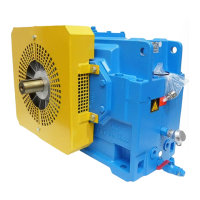88 / 96
BA 5030 en 02/2013
Measures RemarksPeriods
Check cooling coil Every 2 years see item 10.2.6
Check condition of air oilcooler Every 24 months or
10 000 operating hours
see item 10.2.7
Check condition of water oilcooler Ev ery 24 months or
10000 operating hours
see item 10.2.8
Check hose lines Yearly see item 10.2.9
Change the hose lines 6 years from the manufacturing date
impressed
see item 10.2.9
Checking friction linings of
torquelimiting backstop
Once per year at least see item 5.9
Checking auxiliary drive see item 5.14
Check tightness of fastening bolts After first oil change,
then every 2 years
see item 10.2.13
Check shrink disk Every 12 months see item 6.7.5
Inspection of the gear unit Approx. every 2 years see item 10.4
The coating must not carry an electrostatic charge!
The operator must ensure that highly effective mechanisms which can set up a charge
in the coating are safely avoided.
10.1.1 General oilservice lives
According to the manufacturers, the following are the expected periods during which the oils can be used
without undergoing any significant change in quality. They are calculated on the basis of an average oil
temperature of 80 °C:
─ for mineral oils, biologically degradable oils and physiologically safe (synthetic esters) oils 2 years
or 10 000 operating hours (does not apply to natural esters rape seed oils, etc. ).
─ for polyαolefins and polyglycols, 4 years or 20 000 operating hours.
The actual service lives may differ. The general rule is that an increase in temperature of 10 K
will halve the service life and a temperature decrease of 10 K will approximately double the
service life.
10.2 Description of maintenance and repair work
10.2.1 Examine water content of oil / conducting oil analyses
More information about examining the oil for water content or conducting oil analyses is obtainable from
your lubricant manufacturer or our customer service.
• For reference purposes, a fresh sample of the operating lubricating oil used must be sent with the used
oil sample to the analysing institute for analysis.
• The oil sample must be taken downstream of the filter of the oilsupply system while the gear unit is
running. A suitable connection point is normally located upstream of the gear unit input (e.g. oildrain
cock in the pressure line).
• A special sample container should be filled with the specified quantity of oil.
If there is no such sample container available, at least one litre of oil must be put in a clean,
transportworthy, sealable vessel.

